Rippling and Gusto are cloud-based HR payroll systems that can help you hire and pay global and US employees. Both also have features that can handle the entire employee lifecycle. However, Gusto is the ideal choice if you need a small business HR payroll tool, while Rippling is great for those needing a wider HR solution suite that includes basic IT and finance functions.
Here are my recommendations to help you determine whether Rippling vs Gusto is right for your business.
- Rippling: Best all-in-one HR software with strong automation features
- Gusto: Best for small businesses looking for HR and payroll tools to streamline processes
Rippling and Gusto appear in several of our buyer’s guides given the efficient HR and payroll features that they offer. Both rank high in our best payroll software, best payroll services, best HR software, and top HR information systems (HRISes) for small business owners guides. For this article, I used the evaluation metrics in our best HR payroll software guide to compare Gusto vs Rippling.
Rippling vs Gusto Compared
 | ||
|---|---|---|
4.26 out of 5 | 4.72 out of 5 | |
First month is free | ||
Starter Monthly Pricing | $6 per employee + $40 base fee | |
Payment Options | Manual checks and direct deposits | Manual checks, direct deposits, and pay cards |
Employer of Record (EOR) Services
EOR services allow you to compliantly hire and pay international workers without setting up legal entities in countries outside of the US.
| Available in over 185 countries | Available in 12 countries |
Professional Employer Organization (PEO) Services
A PEO provides HR outsourcing services and acts as a co-employer to help you manage payroll, benefits, payroll taxes, compliance, and HR processes.
| ✓ | ✕ |
Employee Health Benefits Coverage | 50 states | 50 states |
Time Tracking | Paid add-on (included in pricing quote) | Included in higher tiers |
Learning Management | Paid add-on | Via third-party apps |
Performance Reviews | ✕ | Included in higher tiers |
IT Tools to Manage Business Apps and Devices | $8 per employee monthly | Included in higher tiers (business app and email management only) |
Third-party Software Integrations | 600+ | 150+ |
Customer Support | Chat and email support; access to HR advisors with live phone support for an extra cost | Chat, email, and phone support; access to HR advisors available in higher tiers |
When to Use Each and Pros & Cons
Rippling & Gusto Top Alternatives
Rippling and Gusto may have efficient HR payroll tools, but if you’re looking for something else, consider the following software:
 | |||
|---|---|---|---|
Best For | QuickBooks users and low-cost contractor payments | Small companies needing dedicated payroll support | Businesses in highly regulated industries |
Starter Monthly Pricing | $6 per employee plus $50 base fee | $5 per employee plus $39 base fee | |
Contractor-only Payments Plan | $15 monthly for up to 20 workers; plus $2 per additional contractor | Included in payroll plan | Included in payroll plan |
Learn More |
Want to know how Rippling and Gusto compare with the above providers and other competitors? Check out some of our “vs” articles below.
- Rippling vs Paychex
- Rippling vs TriNet HR Platform
- Gusto vs QuickBooks Payroll
- Gusto vs BambooHR
- Gusto vs Justworks
- OnPay vs Gusto
- Paychex vs ADP vs Gusto
If you’re unsure which provider to choose, read our guide to finding the right payroll solution.
Best for Value: Gusto
Gusto’s fully transparent pricing and multiple payroll plans are just some of the reasons this provider outscored Rippling, earning perfect marks in this criterion. It also offers a reasonably priced US contractor payroll package—an option that Rippling lacks. This is great for US-based businesses that only employ and pay contractors. New clients who sign up for this plan even get discounted pricing of only $6 per contractor monthly (no base fee) for the first six monthsⓘ, allowing them to save a little on costs.
While Gusto may not have the fully modular system that Rippling offers, it still provides some flexibility if you want to upgrade its starter Simple plan with additional features. Plus, you may end up paying more with Rippling, especially if you get all of its HR, finance, and IT tools.
When comparing Rippling vs Gusto in terms of value for money, Rippling’s custom pricing and the different features in the providers’ plans make it difficult to determine this. However, to see estimated costs, I will use the quote Rippling provided. Even with the time tracking add-on, Rippling’s monthly fee is higher. Gusto’s Simple plan with time tracking is more reasonably priced because it already includes some tools, such as email provisioning and de-provisioning, which cost extra with Rippling.
Let’s compute. For a business with 10 workers, you will pay:
Rippling: $195 monthly
$35 base fee + (10 workers × $8 per-employee fee) + (10 workers × $8 per-employee fee for app and device management add-on) = $195 monthly
Gusto: $160 monthly
$40 base fee + (10 workers × $6 per-employee fee) + (10 workers × $6 per-employee fee for time tracking add-on) = $160 monthly
If you’re unsure whether to get Gusto vs Rippling, take a look at your HR needs and budget. If you don’t have a limited budget and need a feature-rich platform with extensive third-party software integrations to fit your growing HR needs, consider Rippling.
Rippling is also a better choice if you need to recruit and pay international workers. Rippling’s EOR service pricing is slightly lower than Gusto’s EOR, Gusto Global. It will only charge you $599 per employee monthly, while Gusto will bill you a per-employee monthly fee of $699.
Best for Payroll: Rippling
Expert’s Tiebreaker Insight: In the battle between Gusto vs Rippling for pay processing functionalities, both earned 4.75 out of 5 in this criterion. However, I found Rippling a better payroll option because the coverage of its global payments and EOR services is wider than Gusto’s—which is great if you plan to grow your workforce into an international team.
 | ||
|---|---|---|
Our Score | 4.75 out of 5 | 4.75 out of 5 |
Unlimited and Automatic Pay Runs | Unlimited pay runs only | ✓ |
Multi-state Payroll | ✓ | Included in higher tiers |
Tax Payment and Filing Services | ✓ | ✓ |
Year-end Tax Reports (W-2/1099s) | ✓ | ✓ |
Direct Deposit Processing Time | Two days | Two and four days; next-day with premium plans |
Manual Paychecks | ✓ | ✓ |
Pay Card Payments | ✕ | ✓ |
Wage Garnishment Services | ✓ | South Carolina not included |
Global Payroll Capabilities for Employees & Contractors | ✓ | ✓ |
EOR Country Coverage | Over 185 countries | 12 countries |
While both provide unlimited pay runs, payroll tax payments and filings, and year-end tax reporting, Rippling offers multi-state pay runs without requiring you to upgrade to a higher plan. With Gusto, you need to get at least its Plus tier if you want multi-state pay processing.
Further, if you have a global workforce or plan to set up office locations outside of the US, Rippling’s EOR is available in more countries than Gusto. Rated as one of our top international payroll software, it lets you pay both employees and contractors in over 185 countries. Gusto’s EOR is available only in 12 countries.
Rippling may not have Gusto’s multiple payment and direct deposit options, but if you have international staff or plan to set up office locations outside of the US, the Rippling payroll solution can help you manage payments for global employees. Rated as one of our top international payroll software, it lets you pay both employees and contractors, wherever they are working, be it from your corporate headquarters in the US or a satellite office somewhere else in the world (Gusto only handles payroll for international contractors).
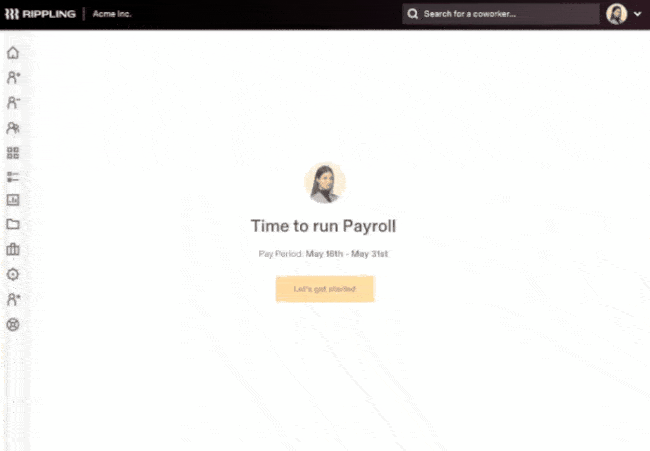
With Rippling, you can process payroll in just a few clicks. (Source: Rippling)
Meanwhile, Gusto is an ideal choice if you primarily want US payroll tools. You can pay employees through paychecks, pay cards, and direct deposits; whereas Rippling has limited payment options. Gusto’s processing timelines for direct deposits are four and two days, but if you sign up for its higher tiers, you get a next-day option.
Plus, its free Gusto Wallet app allows your employees to view payslips, track spending, and save money via a paycheck splitter that automatically transfers funds into different accounts. Rippling doesn’t have a similar app.
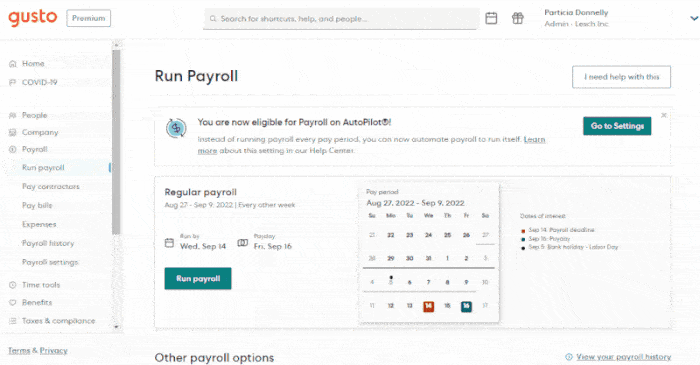
Gusto’s pay runs follow a four-step process. (Source: Gusto)
Best for HR Features: Rippling
Expert’s Tiebreaker Insight: This is another criterion where Rippling and Gusto earned the same score—4.75 out of 5. However, Rippling’s HR solution suite has a slight edge over Gusto, offering more features to support your growing employee management needs. In addition to global hiring services through its EOR, it has a PEO option and a comprehensive line-up of non-standard benefits to help improve worker well-being.
 | ||
|---|---|---|
Our Score | 4.75 out of 5 | 4.75 out of 5 |
Job Postings to Popular Job Boards | ✓ | ✓ |
Applicant Tracking & New Hire Onboarding | ✓ | ✓ |
State New Hire Reporting for Employees & Contractors | Employees Only | ✓ |
Time Tracking & Scheduling | ✓ | Time tracking only |
Standard Benefits Options | Medical, dental, vision, 401(k), FSA, HSA, commuter benefits, ACA and COBRA compliances | Medical, dental, vision, 401(k), FSA, HSA, commuter benefits, ACA/HIPAA/ERISA and COBRA compliances |
Non-standard Benefits Options | Pet insurance, fertility options, and mental health services | Free Gusto Wallet (financial management app) |
Health Insurance Coverage | 50 states | 50 states |
Learning Management | ✓ | Via third-party integration |
Performance Reviews | ✕ | ✓ |
Headcount and Compensation Planning Tools | ✓ | ✕ |
PEO Option | ✓ | ✕ |
Self-Service Portal | ✓ | ✓ |
Rippling’s all-in-one HR platform is equipped to handle simple to complex HR processes given that its suite of HR solutions is wider than Gusto’s. It even has expense-tracking functionalities and IT tools for managing business apps, devices, and computer inventory. This makes it easy for you to manage different functions with just one platform, which also saves you money from investing in separate software.
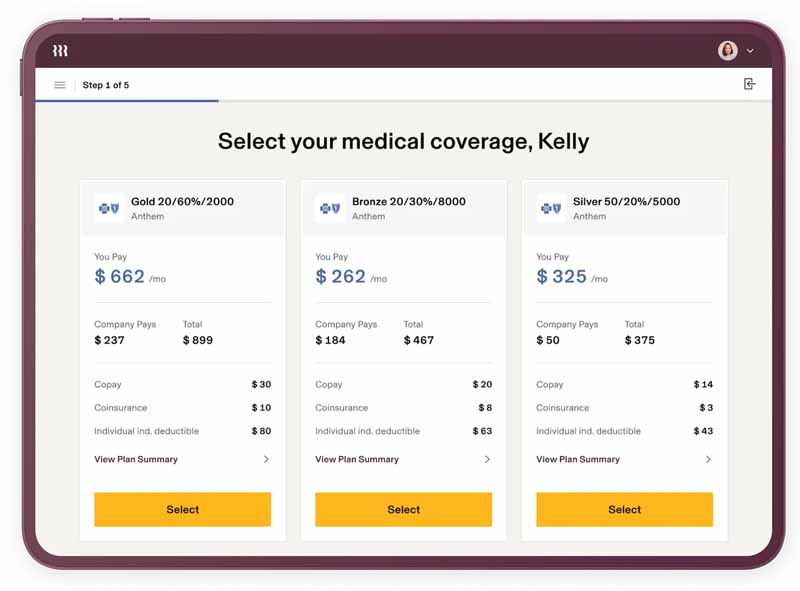
Rippling provides access to popular benefits providers, but you can also opt to use your existing broker for a fee.
(Source: Rippling)
Further, Gusto lacks the PEO services that Rippling offers. This allows you to outsource payroll and day-to-day HR tasks, which is great if your HR needs have grown but you either don’t have an in-house HR staff or are not willing to expand your current HR team.
While most of Gusto’s functionalities are geared toward payroll, the provider also has a solid set of HR solutions for managing employees. Finding qualified candidates to fill open positions is made easy with its job posting, applicant tracking, and hiring tools. You can also onboard new hires, run background checks (via a partner solution, Checkr), track employee attendance, and monitor performance reviews.
In addition, if you want health insurance and are not in one of the states Gusto hasn’t yet expanded to (Alabama, Alaska, Hawaii, Louisiana, Mississippi, Montana, Nebraska, North Dakota, Rhode Island, South Dakota, West Virginia, and Wyoming), signing up for benefits plans will be easy for you and your employees.
To help you confirm whether the state your business is located in is covered, check out the health benefits map below.
Best for Reporting: Rippling
Expert’s Tiebreaker Insight: In our evaluation of Rippling vs Gusto for reporting features, both earned perfect marks in this criterion. However, I found Rippling a better choice if you need more customization options.
 | ||
|---|---|---|
Reporting Score | 5 out of 5 | 5 out of 5 |
Basic HR & Payroll Reports | Available | Available |
Report Customizations | ✓ | ✓ |
While the two providers offer basic HR payroll reports that can be exported for use within multiple departments, Rippling stands out with its analytics tools, library of pre-built reports, and customization options. Unlike Gusto, it has data aggregation capabilities, enabling you to add calculations based on specific data fields.
For example, you want a report that shows the employees’ expected payouts if bonuses are computed based on a fixed percentage of annual salaries (let’s say 3% of the annual salary). Simply select the annual compensation data field in addition to the employee names and other information you want (like department and position title). Then, insert the applicable formula (annual compensation × 0.03) and run (or save) the report. Rippling will automatically calculate the amounts based on the formula you added, which saves you time from manually computing the expected bonuses.
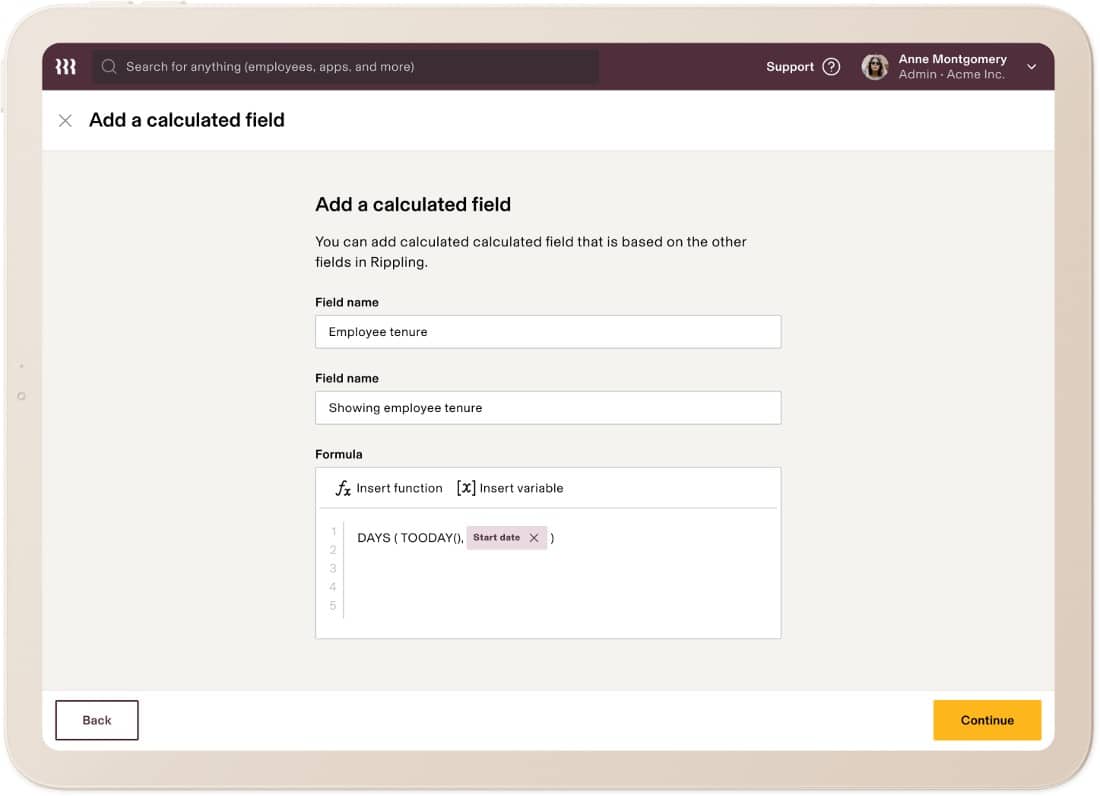
Rippling has Excel-like formulas that you can easily add to your custom reports. (Source: Rippling)
If you require mostly payroll reports to help you track labor and job costs, bank transactions, and agency payments (like federal, state, and local tax deposits), consider Gusto. While it may not have Rippling’s Excel-like formulas that you can add to reports, its payroll journal and employee report builders allow you to create custom report templates that you can save and reuse.
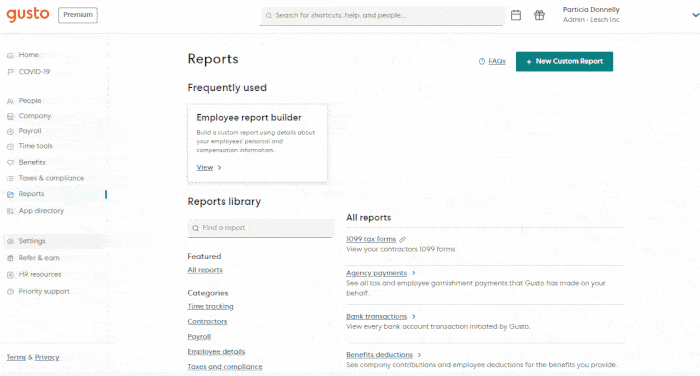
Gusto’s reporting tool allows you to filter and drag-and-drop data fields that you want. (Source: Gusto)
Best for Ease of Use & Customer Support: Gusto
 | ||
|---|---|---|
Our Score | 3 out of 5 | 4.5 out of 5 |
Learning Curve | Relatively easy | Relatively easy |
Ease of Use | Good | Good |
Automation Tools | Excellent | Good |
HR Advisory Services | Paid add-on | Available in highest tier |
Access to a Dedicated Customer Success Manager | ✕ | Available in highest tier |
Customer Support | Chat and email | Chat, email, and phone support |
Online How-to Guides | ✓ | ✓ |
Software Integration Options | Over 600 | Over 150 |
Both providers may have online platforms that are relatively simple to learn and use, with setup wizards to help new users get the software up and running in no time—but Gusto scored higher (4.5 out of 5) in this criterion primarily because of customer support. All of its plans come with unlimited phone, chat, and email assistance, whereas Rippling only has chat and email support. If you get its higher tiers, Gusto offers priority support with access to a direct number to contact with priority access.
How-to guides and FAQs are easily accessible through Gusto’s online help center. Plus, you are granted free access to HR advisory services and a dedicated support representative if you subscribe to its Premium plan. Rippling doesn’t assign a dedicated customer support rep to its clients, and you have to pay extra if you want assistance from HR professionals.
Rippling only scored 3 out of 5 in this criterion because its customer support options are limited compared to Gusto’s. With its chat and email-only support, Rippling is a good option for businesses with in-house HR personnel who are experts in managing HR, payroll, and a cloud-based system—hence, they don’t need constant support. If you do need expert advice from HR professionals and are willing to pay additional monthly fees, Rippling may just be what you need.
While Gusto may integrate with more than 150 third-party systems, it doesn’t beat Rippling’s large network of over 600 partner apps. This is optimal for those who use a lot of business software and want to connect it with Rippling’s HR platform to ensure that employee-related data syncs seamlessly across solutions.
Best for Popularity Among Users: Rippling
 | ||
|---|---|---|
Our Score | 5 out of 5 | 4.13 out of 5 |
User Feedback | Mostly positive | Mostly positive |
Average User Ratings* | 4.85 out of 5 | 4.30 out of 5 |
Average Number of Reviews* | Over 3,050 | More than 3,020 |
*Data from third-party review sites (such as G2 and Capterra) as of this writing | ||
To evaluate Rippling vs Gusto user popularity, we looked at each provider’s average number of user reviews and the average overall ratings on third-party review sites like G2 and Capterra. Both received perfect marks in this category, but in terms of ratings from actual users, Rippling’s average score is higher than Gusto’s (4.85 vs 4.57 out of 5).
What Users Think: Rippling vs Gusto
Methodology: How I Evaluated Rippling vs Gusto
To evaluate the differences between Gusto and Rippling, I compared the HR and payroll features of both providers, including the global payment options that they offer. I also checked both platforms’ popularity among users, ease of use, third-party software integrations, and customer support options. Lastly, I considered pricing transparency and monthly costs.
Click through the tabs below for a more detailed breakdown of the evaluation criteria:
35% of Overall Score
I looked for HR services and functions like online onboarding, state new hire reporting, self-service portals, and a staff of expert advisors. I also gave additional points to software providers offering health insurance available in all 50 states and advanced HR solutions like hiring, compensation, learning, and performance management.
20% of Overall Score
I gave the most credit to solutions that process direct deposits in two days or fewer, have multiple payment options, handle year-end tax reporting, manage tax payments and filings―federal, state, and local taxes―and offer a penalty-free guarantee.
20% of Overall Score
I looked for features that make the software easy to use, such as having an interface that’s intuitive and customizable. Extra points were given to providers that offer integration options, set-up assistance, live phone support, and a dedicated representative.
15% of Overall Score
I checked to see if the provider has transparent pricing, zero setup fees, and multiple plan options with unlimited pay runs. I also gave additional points to those with plans that cost $50 per employee.
5% of Overall Score
Preference was given to software with built-in basic payroll reports and customization options.
5% of Overall Score
I considered online user reviews, including those of our competitors like G2 and Capterra, based on a 5-star scale, wherein any option with an average of 4-plus stars is ideal. Also, software with 1,000 or more reviews on third-party sites is preferred.
Bottom Line
Choosing between Rippling vs Gusto may not be as easy as it seems because both have outstanding features that can make your HR and payroll processes more efficient. However, in finding the right payroll solution, you should first consider the types of features your business currently needs and what it will need in the near future.
If you’re actively hiring, want help purchasing and setting up new computer devices, need learning management tools, or have international employees, consider Rippling.
However, if your company is a small business and you want a solid set of payroll features with multiple payment options, consider Gusto. It offers reasonably priced plans and a US contractor payroll-only package, which is the more affordable option between the two payroll software providers.

